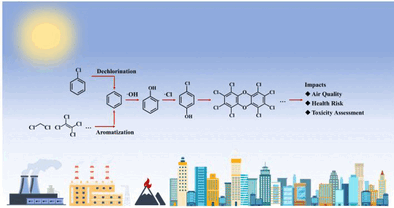Chlorinated organic substances can be converted into dioxins in the atmosphere
Are the risks of hazardous chemicals being determined
appropriately? In certain cases, apparently not–according to a study
published in the journal Angewandte Chemie by a team of Chinese
researchers. The study indicates that chlorinated volatile organic
compounds on mineral dust particles in the atmosphere can be converted
into highly toxic polychlorinated dibenzo-p-dioxins and
dibenzofurans by sunlight.

© Wiley-VCH, re-use with credit to 'Angewandte Chemie' and a link to the original article.
Hazardous chemicals are frequently assessed under national
and international regulatory frameworks, which primarily focus on their
toxic properties, environmental persistence, and accumulation in
organisms. Yet, any transformations they undergo in the atmosphere are
rarely or not at all taken into account, though secondary conversion
products may exhibit higher toxicity and persistence. These should be
investigated to adequately evaluate risks posed by commercial chemicals
to the environment and human health.
In this capacity, a team led by Xiaole Weng at Zhejiang
University (Hangzhou, China) has examined chlorinated volatile organic
compounds (CVOC). These important commercial chemicals are widely used
in industry and agriculture, including in paints and varnishes, dry
cleaning, and paint stripping. Waste incineration plants and landfills
are also significant CVOC emitters. Growing industrialization will
increase CVOC emissions still more, especially in developing countries.
CVOCs are known to be precursors to dioxin compounds in industrial
combustion processes. Catalyzed by flue ash, for
example, chlorobenzenes can be converted into polychlorinated dibenzo-p-dioxins
and dibenzofurans (PCDD/Fs). Many compounds in this group are toxic and
carcinogenic, as vividly demonstrated by the devastating chemical
accident in Seveso in 1976. However, there is little data about the
persistence and potential chemical conversions of CVOCs in the
atmosphere.
Atmospheric particles contain substances like iron and
aluminum minerals, which can be catalytically active. The team hypothesized that
these catalyze the conversion of CVOCs into PCDD/Fs under solar
radiation, acting as an important, overlooked source of dioxins. To test
this hypothesis, the researchers carried out laboratory experiments on a
variety of mineral particles and identified possible reaction pathways
based on computer models. A subsequent field trial with ambient air and
fallen ash in an industrial park confirmed the occurrence of these
photochemical conversions in the atmosphere.
The results prove that ubiquitous CVOCs, such as
monochlorobenzene, dichloromethane, and perchloroethylene could be the
overlooked precursors for PCDD/Fs. Iron oxides (α-Fe2O3)
in particular, play a role in the production of chlorophenols and dioxin
compounds. Tests on mice also demonstrated that after these
photochemical reactions, the iron oxide dust caused severe damage to
lung and brain tissue.
This study underlines the need to reassess the toxicity of
atmospheric precursor pollutants like commercial CVOCs, as well as their
conversions.
(3129 characters)
About the Author
Dr. Xiaole Weng is a Professor at Zhejiang University and
chairs the Department of Environmental Engineering. His research
specializes in air pollution control and environmental catalysis.
Copy free of charge—we would appreciate a transcript/link of your
article. The original articles that our press releases are based on can
be found in our online pressroom.